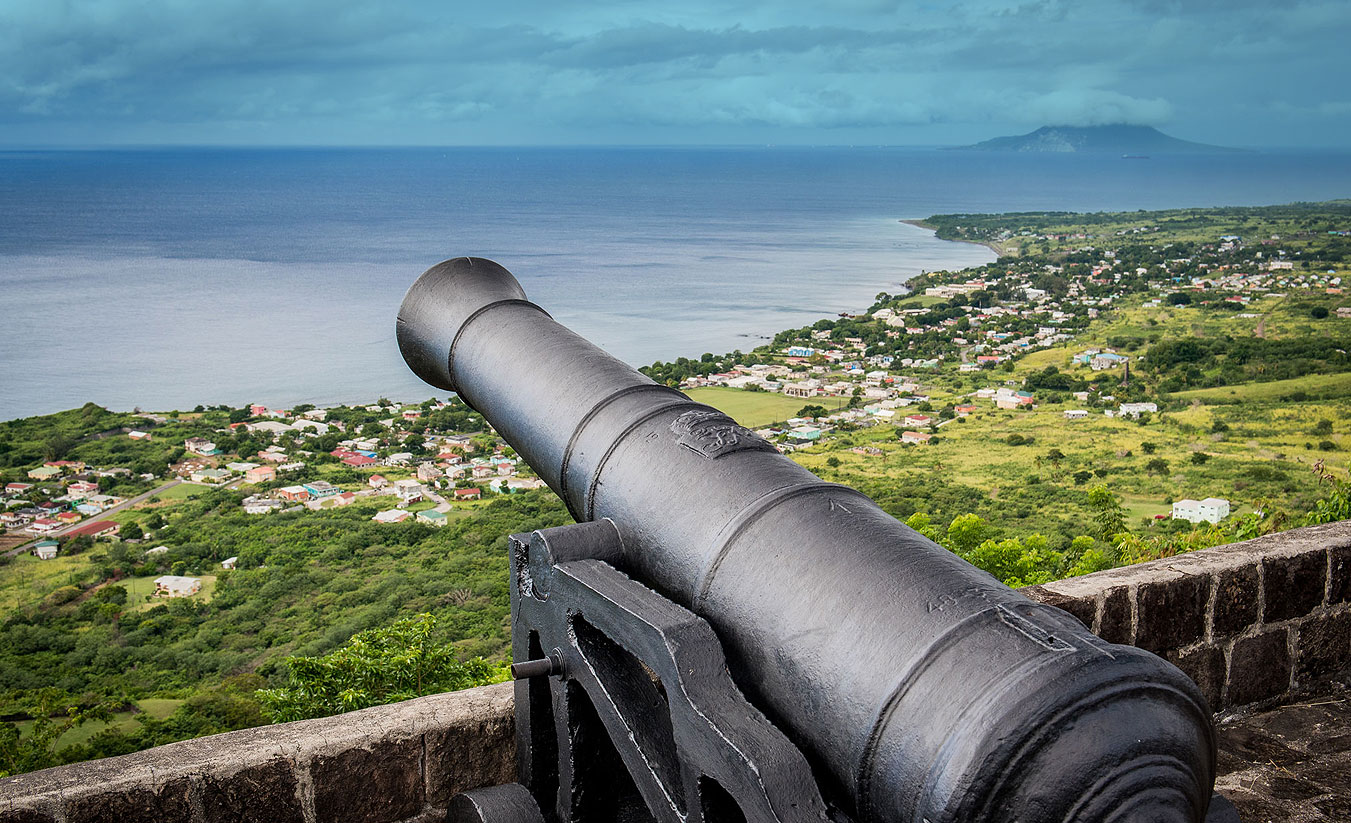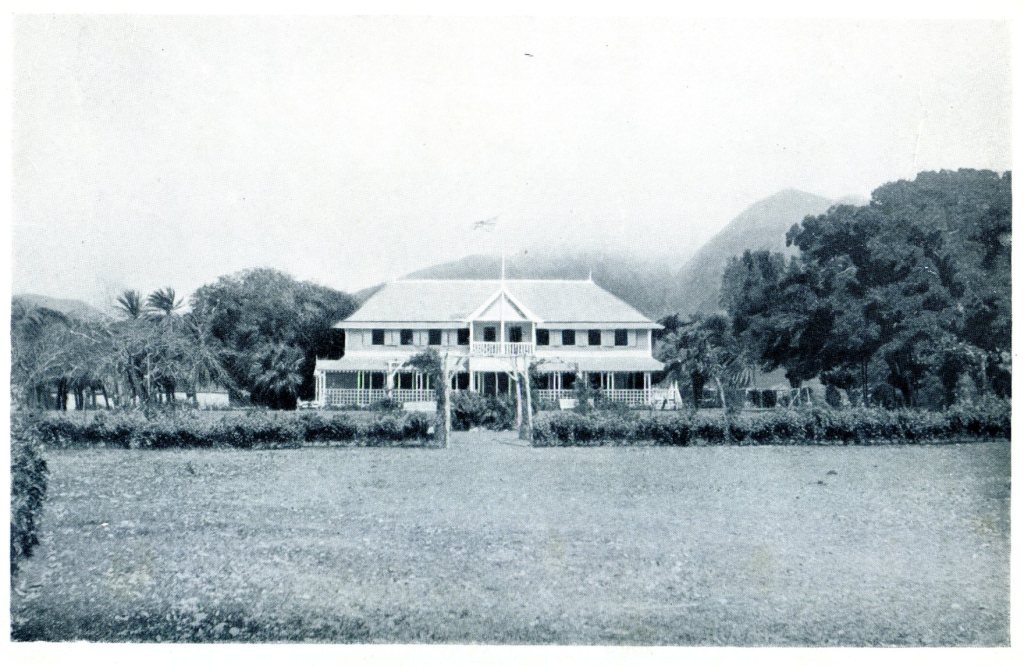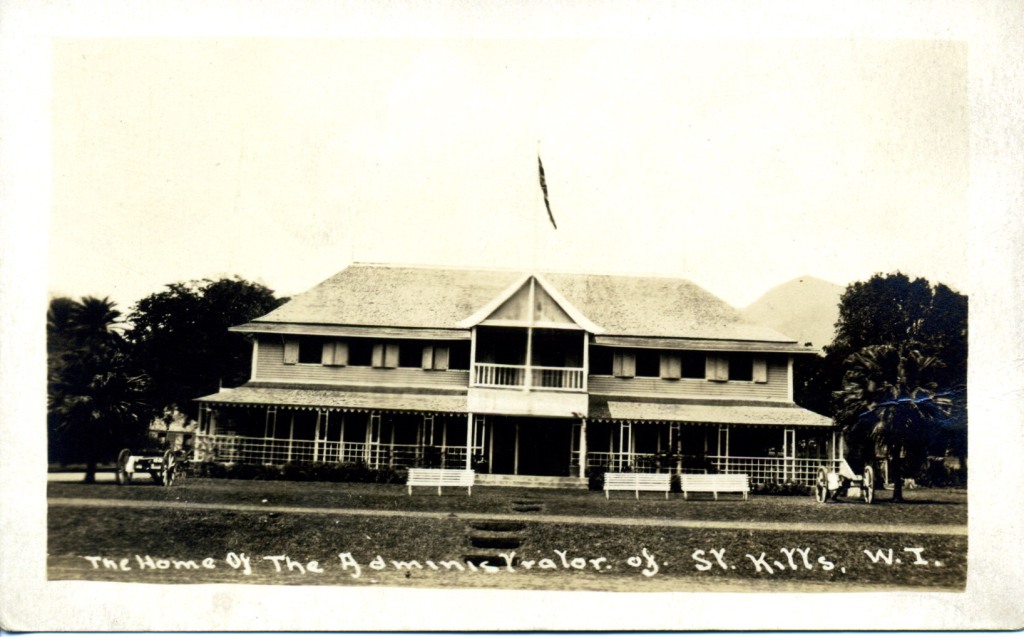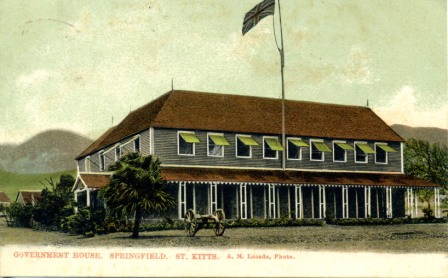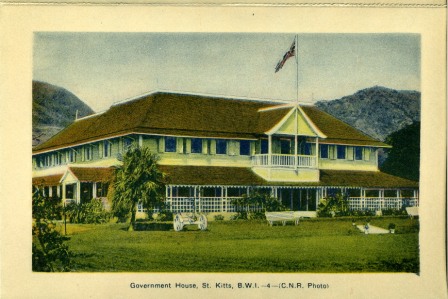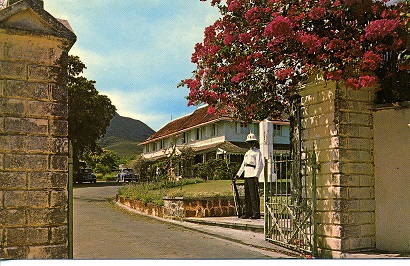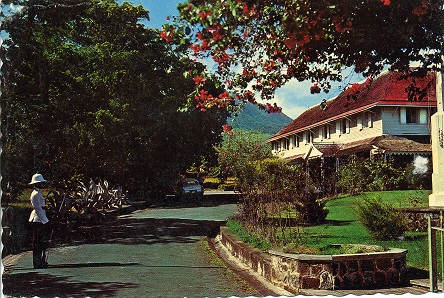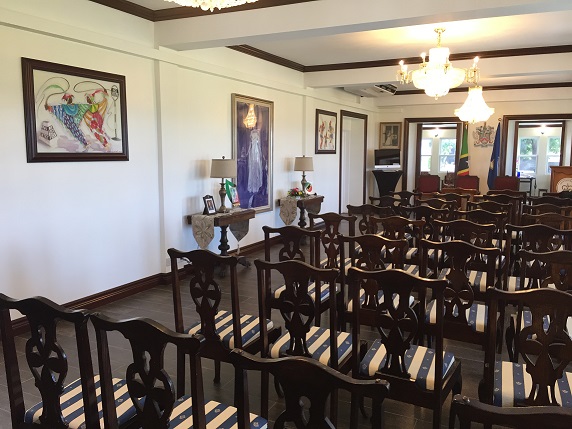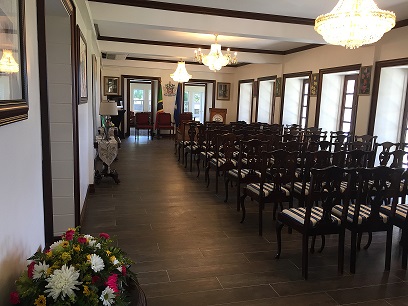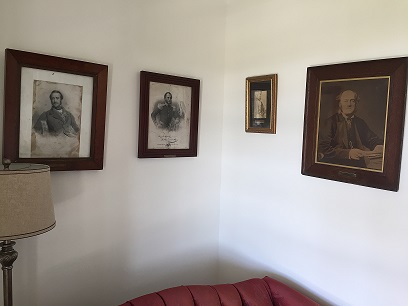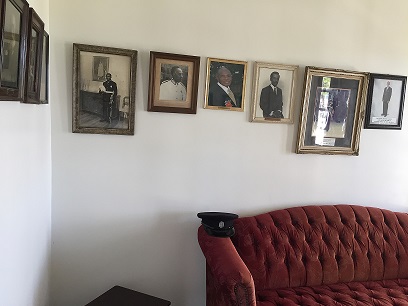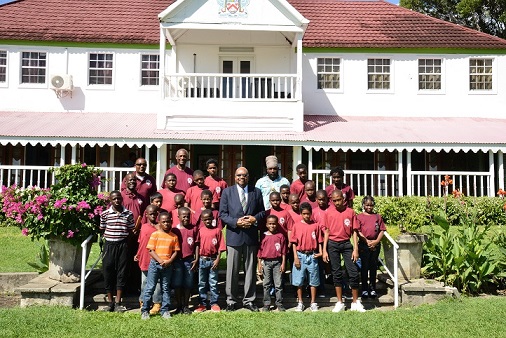
Government House 2015
The land that became known as Springfield was a small part of Diamond Estate. It 1828 it was the property of Sir James Henry Blake, the second son of Sir Patrick Blake of Langham, an absentee land owner. Besides Diamond, he also owned Pinnel, an estate of one hundred and ninety seven acres in the Parish of St. Ann and had land in Montserrat and the counties of Middlesex, Suffolk and Sussex in England. Diamond consisted of one hundred twenty-four acres of land of which one hundred thirteen acres were under cane. The rest was grassland and land occupied by sugar works and slave quarters. The estate was physically divided into two.
The Blakes, being absentee planters, were leasing the estate to William Derrickson Beard who had previously been their manager. There was on it a population of sixty-two slaves, fifteen of whom were too young to work and one, a man in his forties was infirm. The majority were employed as field hands and grass pickers. There were also a distiller, a carpenter, two coopers and one boiler who would have worked on the estate in crop time and might have been hired out to neighbouring estates once the canes of Diamond had been processed. There were three house servants - a house boy, a house maid and a cook. As they were not resident, the Blakes left their managers to provide for their own comfort.
In 1837, Sir Henry Blake sold the twenty-five acre lot to Thomas Harper who renamed it Springfield and built a house on it. Because the latter ran into debt, the property passed into the hands of Robert Sharry Harper trustee under the marriage settlement of Mary Sharry Harper nee Amory.
The Brathwaite Scandal
On the 29th September 1848, the estate and its house was mortgaged to the Reverend Francis Robert Brathwaite but before long the Rector was forced into an extended leave of absence following accusations of a public scandal. He returned to St. Kitts in 1853. George Moffat, Captain of the barque Parrock Hall and a frequent visitor to the island, described him as “a complete Giovanni in canonicals.” The Archdeacon’s behaviour was blamed for the madness of Mary Berridge, a member of a prominent Kittitian family, and her eventual death. In a letter to his wife dated 28th January 1854, Moffat explained, He seduced her some seven or eight years ago under promise of marriage; he subsequently proposed to her niece but was refused; he has since been engaged to several other ladies, while still more serious charges are accumulating against him. I think Miss Berridge had always hoped he would eventually do her justice, she ever severely repressed her feelings but at last could hope no longer, and brain first, and life next, gave way. At the funeral Mr. Braithwaite met the body at the gate of the churchyard in company with the other clergymen (he, Mr. Braithwaite, not being allowed to do any duty) and stood close to her family around the grave! I should, had I been her brother, been tempted to knock him in.
Bishop Daniel G. Davis in Antigua warned Braithwaite not to attempt to take up his official position in St. George’s until an investigation had taken place. Davis, a man of integrity and social commitment, was a Kittitian and would have been familiar with some of the well-established families on the island. He could not afford to antagonize the Berridges and their circle, many of whom would have been friends of his from childhood. Nor was he likely to tolerate such irresponsible behaviour from a man under his jurisdiction. Braithwaite preferred to resign rather than answer questions about his conduct.
In 1854, news of a virulent cholera epidemic in the Caribbean started reaching St. Kitts. The deadly disease made its way to Kittitian shores before the end of the year. The Cunningham Hospital could not handle the number of persons needing attention. The proximity of cholera victims to patients in the hospital was a health hazard. The house at Springfield presented a solution to the dilemma and was quickly set up as a house of refuge for the diseased and destitute.
Anglican Rectory
In April 1855 the 25 acres of Springfield Estate was conveyed in trust among other things for such public uses and purposes as from time to time should by the Governor, Council and Assembly be declared and appointed. Soon after the Artillery Corps started drilling on the estate grounds while Reverend Henry Willoughby Jermyn, who had succeeded Braithwaite, expressed a willingness to use the house as his rectory. The Administration saw this as an opportunity to save on rent for the accommodation of the minister responsible for St. George’s. Repairs were started immediately and in February 1856 Archdeacon Jermyn moved in.
Archdeacon Gibbs
Archdeacon Jermyn was succeeded by William Poore in 1858. In 1861 Archdeacon George Meade Gibbs took charge of the Parish and two years later he hosted the Rev. John Duport, a Kittitian of African descent, who had been sent to Africa as a missionary. On the 17th August 1863 an open air service was held on the lawn at Springfield. It is reported that it attracted a congregation of over three thousand who went to hear Duport speak. The missionary’s visit was a memorable event which was recorded in the photographs that were distributed to interested parties abroad and sold locally to raise funds for his mission.
In 1872, Henry Booth who came to St. Kitts to build the new organ at St. George’s visited Springfield House and commented on it in his diary. On the grounds Booth noted the large number and wide variety of trees. He was especially interested in the giant Banyan.
The 1860s saw a change in the attitude towards the church. Its privileged position as the Established Church of Great Britain and most of its Colonies was coming into question. The Colonial Office recommended the disestablishment and disendowment of the Church of England in the Crown Colonies on the ground that it included only a small minority of the population. It was therefore difficult to justify the States’s payment of the Church’s expenses. In St. Kitts the disestablishment of the Church was enshrined in Act 7 of 1874 which however preserved the rights of the existing incumbents. When Archdeacon Gibbs retired in 1882, Springfield House was again available for use by the island’s administration.
Eldridge’s Troubles
In June 1882, C.M. Eldridge was appointed President of St. Kitts. On his arrival he was allowed to occupy Government House till the 1st August. By then both houses were in need of repair but Springfield seemed to be faring worse. In June 1883, President Eldridge asked permission to leave Springfield and move back to Government House on Victoria Road as he did not feel that the dwelling could last through a difficult hurricane season. The extensive damage must have been the result of exposure of a wooden structure to tropical conditions. The rains that had caused the flood of January 1880 would have exacerbated the problem.
The building was inspected by William Woolward, master carpenter. He found that the ground floor, which was built in stone, was still in very good condition but the upper storey was in dire need of repair. It required new sills, new beams throughout, new roof, new flooring, new boards, shingles, and casing for sides, new partitions and staircase to a total of £600. The only portion of the house remaining in anything like good order being the roof and floor of the small room above the pantry and about two-third of the uprights of the building itself
in April 1884 Eldridge again wrote to the Colonial Secretary insisting Springfield is barely habitable, and in consequence of the leaks, I would gladly have moved could I have obtained quarters. He complained that the scarcity of houses made finding alternative accommodation very difficult. He made another appeal in 1887. The dilapidated state of the house in 1883 has gradually increased, it is now neither wind nor water tight, and the Surveyor of works has declared that it is not safe in Hurricane season. I therefore pray that these repairs may be commenced before the wet season sets in, as my family have already suffered from the exposure to damp. There was little that he could do to make his family comfortable as he was not allowed to draw he £60 rent allowance which would have been his had Springfield not been available. Further, the salary of £1000 which had been voted for his post was reduced to £800 on instructions from the Secretary of State.
Work on the house finally got started that same year. The President visited the site regularly and commented he had never seen a building so thoroughly worm eaten. The whole roof with the exception of one rafter had to be replaced. By October the sum of £258 15s. had been spent and it was estimated that a bath house, wine room and pantry were going to cost another £60. The President became very enthusiastic about the project and even used his own money to pay for the roof of the pantry and bath room. He hoped that this would be repaid to him from the vote for general repairs. He also started making plans to improve the grounds at his own expense until he heard of the possibility of the land being taken up for the expansion of the Methodist part of Springfield cemetery. Eldridge complained that this proposal would so impair the sanitary condition of the house as to render the place untenable.
Finally the future of the whole project was in question when the Governor refused to sanction any further repairs to Springfield House unless the President’s salary was reduced again. Eldridge was horrified. No longer a young man, and with years of service behind him he found the suggestion shocking especially as such a cut would also affect his pension. It was something that he did not have to worry about. Eldridge died in October of 1888. James Henry, who had been the President’s butler was asked to remain as caretaker until the arrival of the new president. The furniture which had belonged to the late President was sold leaving the house empty. A considerable amount of lumber from the construction work remained on the premises. Henry continued to look after the place till April 1889.
Economy
J. S. Churchill, Eldridge’s replacement must have been made aware of the problems experienced by his predecessor. Not wanting to be burdened with furnishing Springfield at his expense, he offered a business solution. He asked that the reception rooms be furnished by a loan taken by the Government and that he and his successors should be bound to pay 10% annually over a period of twenty years. When the debt was fully paid the furniture would remain the property of the Government.
In 1895 T. Risley Griffith was appointed Administrator of St. Kitts. Soon after his arrival, he had to prepare the dwelling for the Governor’s visit. Numerous items of furniture were removed from Government House and placed at Springfield furnishing the dining room and two bedrooms. Living room furniture was to be purchased in an upcoming sale. By the 27 January 1897 the drawing room and another bedroom were also ready. There were new kitchen utensils in the house but Risley Griffith reported, there is no linen of any kind or description nor is there any cutlery or plate in the house, but with these exceptions, I think I may say that Springfield House is sufficiently furnished to make Your Excellency and Lady Fleming and a private Secretary fairly comfortable. He blamed the tardiness of the Crown Agents for the lack of these items. He offered to make some available from Government House and suggested that the Governor might want to bring linen and cutlery with him.
Springfield house contained a grand entrance hall and a separate dining room and drawing room of significant proportions. There were five bedrooms, the largest measuring 22 feet by 18 feet and the smallest measuring 11 feet by 18 feet. The windows and doors were installed with gauze jalousies to protect the inhabitants against mosquitoes. There was a pasture in front of the house and a patch of guinea grass in the back of it. Tennis and croquet courts were on the grounds and the garden contained a few ornamental shrubs and flowers all of which were maintained by convict labour. The house was furnished by the government which was also supposed to provide such essentials as plate, linen, crockery and glass, candlesticks and lamps. Candles and oil however were at the expense of the governor.
In 1900 Administrator Charles Cox asked for a vote for furnishings. He also wanted a piano to be purchased in England for £60 and was prepared to pay 5% annually towards the cost. An Angelus Player Piano and a quantity of roll was purchased in 1915 from Sir Herbert Marshal for the price of £120. When Administrator, J. A. Burdon, took over the following year he found that the piano was not working. He attempted unsuccessfully to have it repaired locally and finally sent parts back to England. The manufacturers said that they had not been told that the instrument had been purchased for a Government House in the tropics. If they had known they would have recommended a different instrument which would also have been more expensive. The silent instrument was sold at auction for just over £28 and a good second hand piano was bought locally for the price of £50.
In July 1909 the sum of £250 was voted for the erection of a carriage house and stable at Springfield. Up to that time, the Administrator had used the stables of the Municipal Department, at La Guerite but his arrangement had been inconvenient as those stables might be required at any time for the stabling of the stock necessary for the scavenging of the town. In 1925 Administrator J.R. St. Johnston arrived in St. Kitts. He described Springfield in his book From a Colonial Governor’s Notebook (London, Hutchinson, 1936, p.123-124)
The use of Government House on Victoria Road as an official residence came to an end during the war years and in 1946, the dwelling became the home of the Girl’s High School. From then on Springfield became the official residence of the Her Majesty’s representative on the island. In 1967, the Governor of Associated State of St. Kitts, Nevis and Anguilla, Sir Fred Phillips was resident there. He was followed by Sir Milton Allen, the first Kittitian of African descent to hold the post. The house continued to be maintained by Public Works but very little structural change took place until 2004 when a large dinning room was added and the offices of the Governor General and his staff were expanded. The house is currently occupied by Sir Cuthbert Sebastian the second person to hold the title of Governor General of St. Kitts and Nevis.
Governors
- Sir Fred Phillips 1967-1969 (Sir Fred Phillips, Caribbean Life and Culture: A Citizen Reflects (Jamaica, Heinemann, 1991)
- Sir Milton Allen 1969-1975
- Sir Probyn Innis 1975-1981
- Sir Clement Arrindell 1981-1983
Governors General
- Sir Clement Arrindell 1983-1996
- Sir Cuthbert Sebastian 1996-2013
- Sir Edmund Lawrence 2013-2015
- Sir S W Tapley Seaton 2015-

